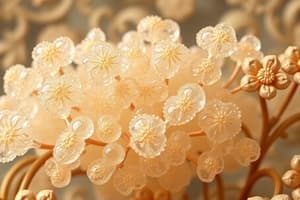Podcast
Questions and Answers
What is the primary element composition of carbohydrates?
What is the primary element composition of carbohydrates?
- Carbon, oxygen, and nitrogen
- Carbon, hydrogen, and phosphorus
- Hydrogen, nitrogen, and sulfur
- Carbon, hydrogen, and oxygen (correct)
Which type of carbohydrate is formed by linking two monosaccharides?
Which type of carbohydrate is formed by linking two monosaccharides?
- Polysaccharide
- Monosaccharide
- Oligosaccharide
- Disaccharide (correct)
What does the prefix 'mono-' in monosaccharide indicate?
What does the prefix 'mono-' in monosaccharide indicate?
- Many units
- Single unit (correct)
- Two units
- Complex structure
Which of the following is an example of a monosaccharide?
Which of the following is an example of a monosaccharide?
What structural form can carbohydrates exhibit?
What structural form can carbohydrates exhibit?
Study Notes
Carbohydrate Structure
- Carbohydrates are organic compounds composed of carbon, hydrogen, and oxygen.
- The general structure consists of a carbon chain or ring, with hydrogen atoms and hydroxyl groups (-OH) attached.
- The ratio of hydrogen to oxygen atoms in carbohydrates is typically 2:1, similar to water (H2O).
Classifying Carbohydrates
- Carbohydrates are categorized based on the number of saccharide units they contain.
- A saccharide is the basic building block of carbohydrates.
- Monosaccharide: Contains one saccharide unit.
- Disaccharide: Contains two saccharide units.
- Oligosaccharide: Contains 3 to 10 saccharide units.
- Polysaccharide: Contains more than 10 saccharide units.
Monosaccharides
- Glucose: Primary energy source for cellular respiration, found in many foods.
- Fructose: Occurs naturally in fruits.
- Galactose: Found in dairy products and certain vegetables.
- All three monosaccharides have the same chemical formula (C6H12O6), but differ in their structural arrangements (isomers).
- Glucose, fructose, and galactose can exist in both linear and ring forms.
Disaccharides
- Sucrose: Made of glucose and fructose, commonly known as table sugar.
- Maltose: Composed of two glucose molecules, found in grains and certain candy.
- Lactose: Made of galactose and glucose, the sugar found in milk.
- All three disaccharides share the same chemical formula (C12H22O11).
Oligosaccharides
- Contain 3 to 10 saccharide units, Examples include:
- Oligofructose: A chain of fructose molecules.
- Raffinose: Contains galactose units, found in human milk.
- Maltotriose: Contains glucose units, present in the small intestine.
Polysaccharides
- Consist of more than 10 saccharide units, examples include:
- Amylose: A simple starch, primarily glucose units, energy storage for plants.
- Glycogen: The primary glucose storage form in animals, serves as an energy reserve.
- Both amylose and glycogen have the general formula (C6H10O5)n, where n indicates the number of glucose units.
Non-starch Polysaccharides (Fiber)
- Complex carbohydrates that the body cannot easily digest.
- Contribute to the bulk of food and aid in digestion.
- Cellulose: Insoluble fiber found in plants, composed of glucose molecules with beta glycosidic linkages.
- Inulin: A dietary fiber found in various fruits, vegetables, and herbs, comprised of fructose molecules.
Properties of Carbohydrates
- Composed solely of carbon, hydrogen and oxygen atoms.
- Can exist in both linear and ring structures.
- Share the same chemical formula but differ in structural and spatial arrangements (isomers).
- Can be oxidized to carboxylic acids.
- Can be reduced to alcohol in their open chain form.
- Typically have a sweet taste.
- Are solid at room temperature.
- Highly soluble in water due to their hydrophilic nature (water-loving), enabling them to function well in aqueous cellular environments.
Studying That Suits You
Use AI to generate personalized quizzes and flashcards to suit your learning preferences.
Description
Explore the fascinating world of carbohydrates, including their general structure and classification into monosaccharides, disaccharides, oligosaccharides, and polysaccharides. Learn about key examples such as glucose, fructose, and galactose, and their significance in biology. This quiz will test your understanding of these essential organic compounds.


